HiPDERL: An Improved Implementation of the PDERL Viewshed Algorithm and Accuracy Analysis
Abstract
1. Introduction
2. Related Works
2.1. Viewshed Algorithms
2.2. PDERL Algorithm
2.2.1. Fundamental Ideas
2.2.2. Implementation Details
3. HiPDERL of Improvements on PDERL Algorithm
3.1. Checking Algorithm for PDERL
3.2. Existing Problems
3.2.1. Problem 1: Unprocessed Column
3.2.2. Problem 2: Flaws within the Error Avoidance Mechanism
3.2.3. Problem 3: Float Number Accuracy
3.3. HiPDERL: An Improved PDERL Implementation Algorithm
4. Experimental Results
4.1. Experimental Environments
4.2. Experiments on Accuracy
4.2.1. Analysis of Implementation Flaws
4.2.2. Analysis of Float Number Accuracy
4.2.3. Comparison Experiment on Accuracy
4.3. Comparison Experiment on Efficiency
5. Conclusions
Author Contributions
Funding
Data Availability Statement
Acknowledgments
Conflicts of Interest
References
- Dou, W.; Li, Y.; Wang, Y. A fine-granularity scheduling algorithm for parallel XDraw viewshed analysis. Earth Sci. Inform. 2018, 11, 433–447. [Google Scholar] [CrossRef]
- Bongers, J.; Arkush, E.; Harrower, M. Landscapes of death: GIS-based analyses of chullpas in the western Lake Titicaca basin. J. Archaeol. Sci. 2012, 39, 1687–1693. [Google Scholar] [CrossRef]
- Li, J.; Zheng, C.; Hu, X. An Effective Method for Complete Visual Coverage Path Planning. In Proceedings of the 2010 Third International Joint Conference on Computational Science and Optimization (CSO), Huangshan, China, 28–31 May 2010; Volume 1, pp. 497–500. [Google Scholar]
- Cervilla, A.; Tabik, S.; Romero, L. Siting multiple observers for maximum coverage: An accurate approach. Procedia Comput Sci. 2015, 51, 356–365. [Google Scholar] [CrossRef][Green Version]
- Qiang, Y.; Shen, S.; Chen, Q. Visibility analysis of oceanic blue space using digital elevation models. Landsc. Urban Plan. 2019, 181, 92–102. [Google Scholar] [CrossRef]
- Franklin, W.R.; Ray, C.K.; Mehta, S. Geometric Algorithms for Siting of Air Defense Missile Batteries; Research Project Report, Contract Number DAAL03-86-D-0001, Delivery Order number 2756; Battelle Columbus Division: Columbus, OH, USA, 1994. [Google Scholar]
- Yaagoubi, R.; Yarmani, M.E.; Kamel, A.; Khemiri, W. HybVOR: A voronoi-based 3D GIS approach for camera surveillance network placement. ISPRS Int. J. Geo-Inf. 2015, 4, 754–782. [Google Scholar] [CrossRef]
- Gonçalves, A.B.; Almeida, J.; Rua, H. Assessment of the Permeability of Historical Defensive Systems: The Case of the Lines of Torres Vedras. Int. J. Hist. Archaeol. 2016, 20, 229–248. [Google Scholar] [CrossRef]
- Gillings, M. Mapping invisibility: GIS approaches to the analysis of hiding and seclusion. J. Archaeol. Sci. 2015, 62, 1–14. [Google Scholar] [CrossRef]
- Zhu, G.; Li, J.; Wu, J.; Ma, M.; Wang, L.; Jing, N. HiXDraw: An Improved XDraw Algorithm Free of Chunk Distortion. ISPRS Int. J. Geo-Inf. 2019, 8, 153. [Google Scholar] [CrossRef]
- Wang, J.; Robinson, G.J.; White, K. Generating viewsheds without using sightlines. Photogramm. Eng. Remote Sens. 2000, 66, 87–90. [Google Scholar]
- Izraelevitz, D. A fast algorithm for approximate viewshed computation. Photogramm. Eng. Remote Sens. 2003, 69, 767–774. [Google Scholar] [CrossRef]
- Zhi, Y.; Wu, L.; Sui, Z.; Cai, H. An improved algorithm for computing viewshed based on reference planes. In Proceedings of the IEEE 2011 19th International Conference on Geoinformatics, Shanghai, China, 24–26 June 2011; pp. 1–5. [Google Scholar]
- Dou, W.; Li, Y. A fault-tolerant computing method for Xdraw parallel algorithm. J. Supercomput. 2018, 74, 2776–2800. [Google Scholar] [CrossRef]
- Tabik, S.; Zapata, E.L.; Romero, L.F. Simultaneous computation of total viewshed on large high resolution grids. Int. J. Geogr. Inf. Sci. 2013, 27, 804–814. [Google Scholar] [CrossRef]
- Stewart, A.J. Fast horizon computation at all points of a terrain with visibility and shading applications. Vis. Comput. Graph. IEEE Trans. 1998, 4, 82–93. [Google Scholar] [CrossRef][Green Version]
- Tabik, S.; Cervilla, A.R.; Zapata, E.; Romero, L.F. Efficient data structure and highly scalable algorithm for total-viewshed computation. IEEE J. Sel. Top. Appl. Earth Obs. Remote Sens. 2015, 8, 304–310. [Google Scholar] [CrossRef]
- Sanchez-Fernandez, A.J.; Romero, L.F.; Bandera, G.; Tabik, S. A data relocation approach for terrain surface analysis on multi-GPU systems: A case study on the total viewshed problem. Int. J. Geogr. Inf. Sci. 2020, 35, 1500–1520. [Google Scholar] [CrossRef]
- Wu, C.; Guan, L.; Xia, Q.; Chen, G.; Shen, B. PDERL: An accurate and fast algorithm with a novel perspective on solving the old viewshed analysis problem. Earth Sci. Inform. 2021, 14, 619–632. [Google Scholar] [CrossRef]
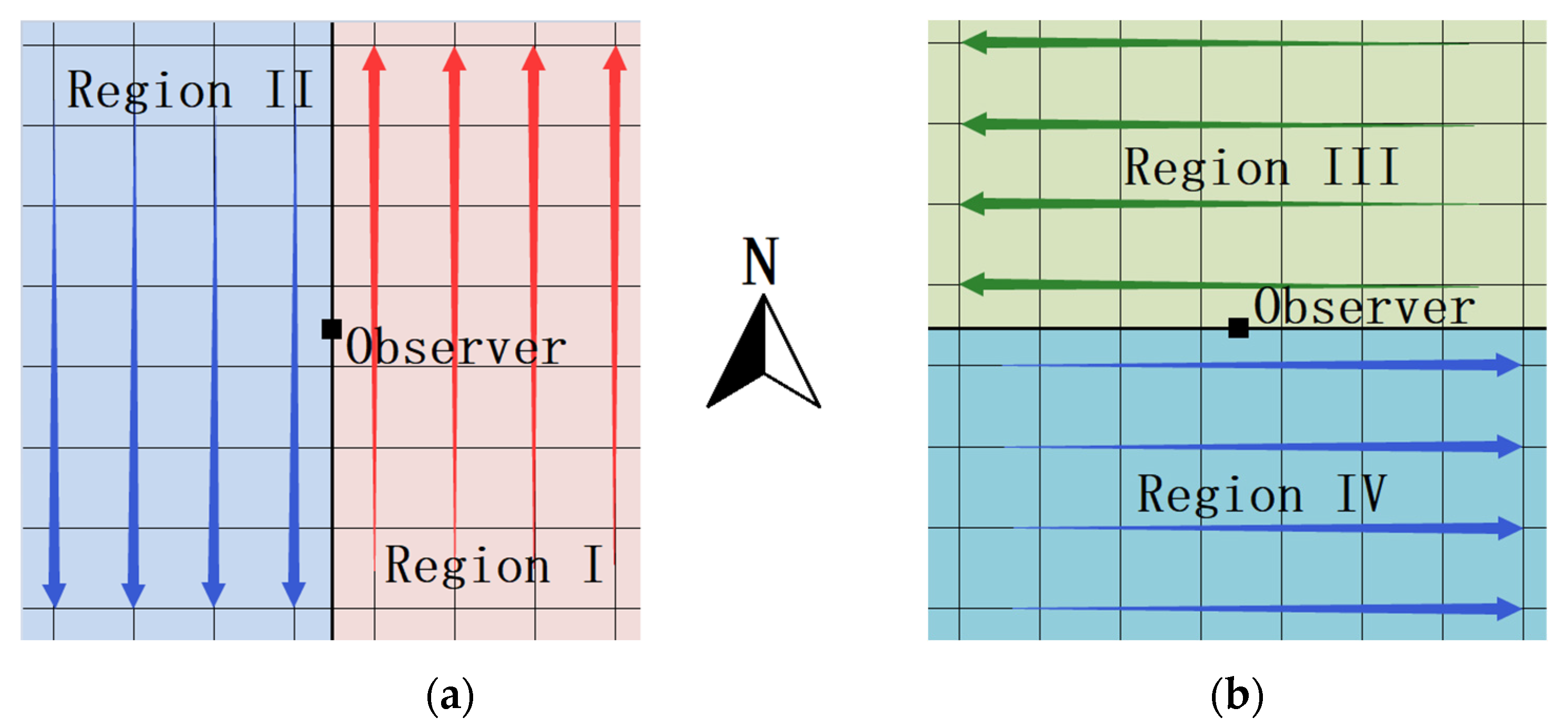
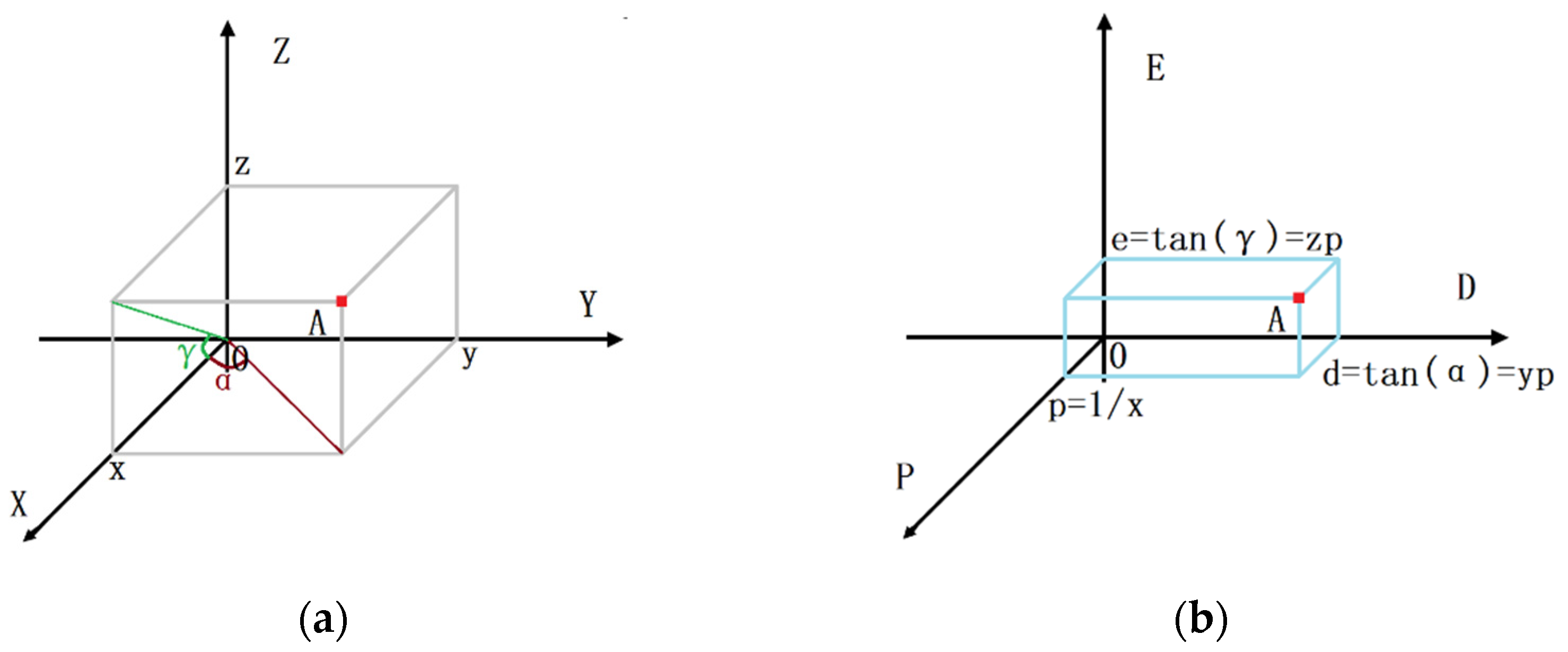
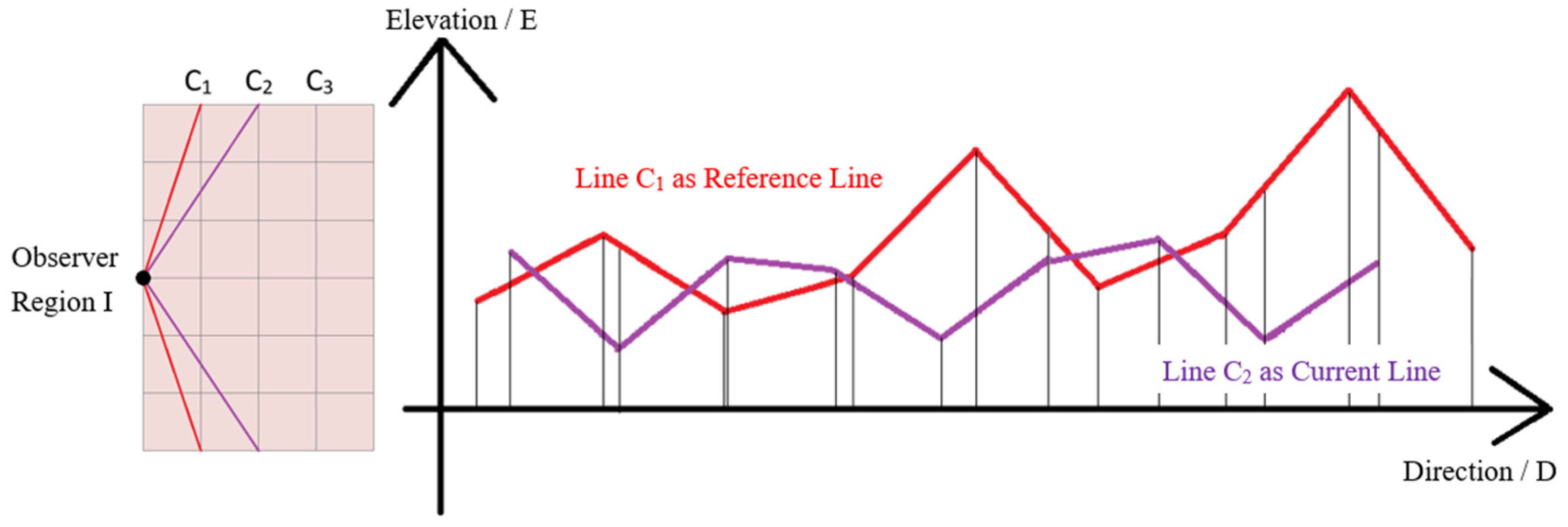
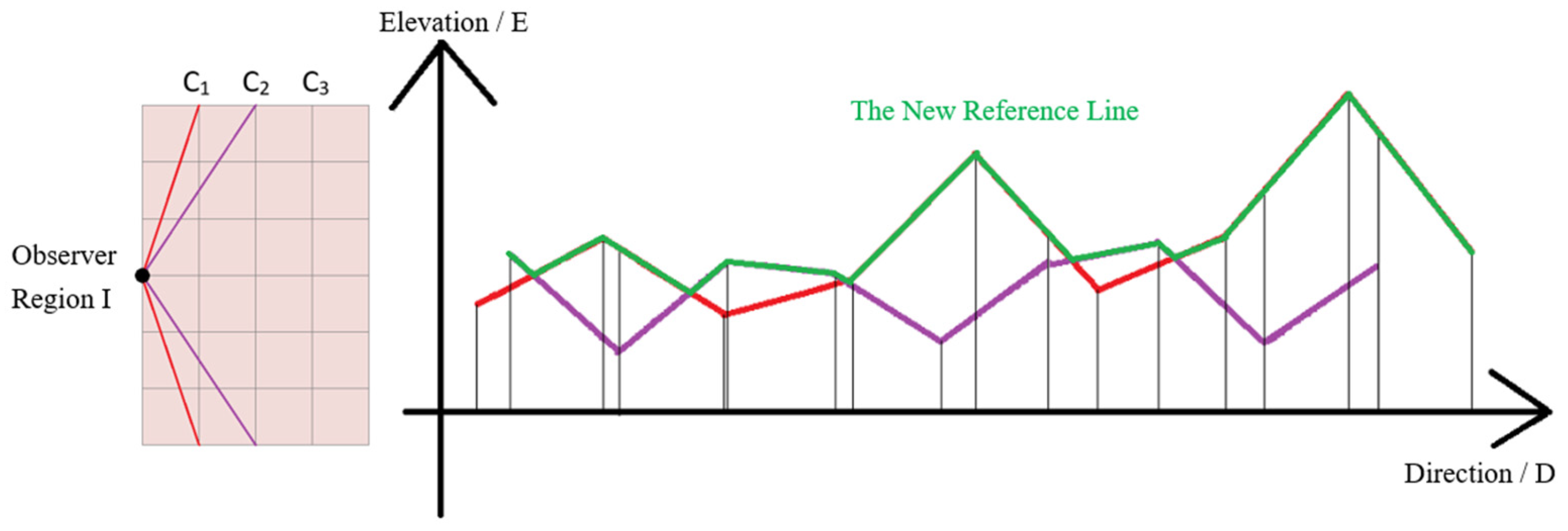

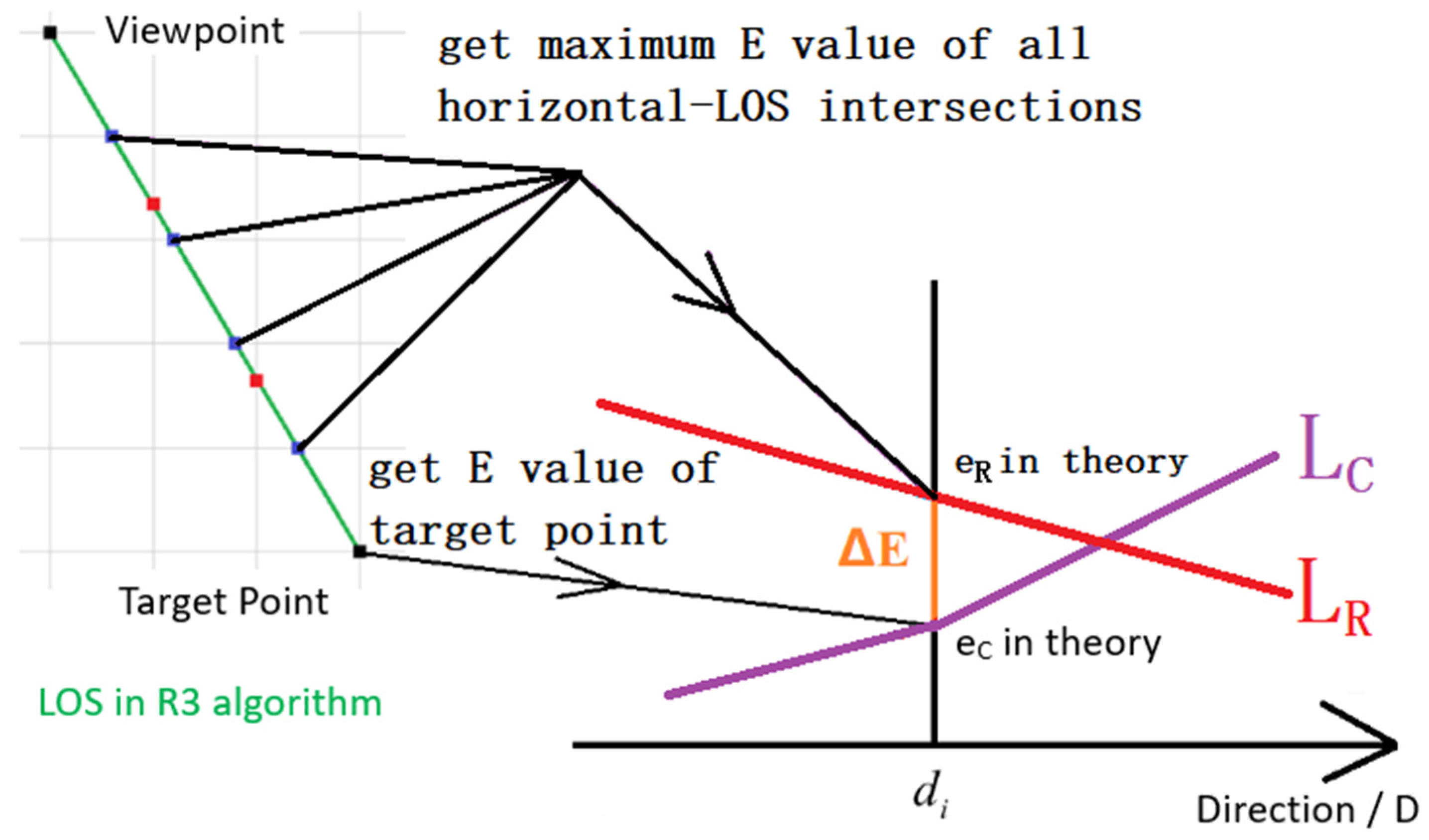
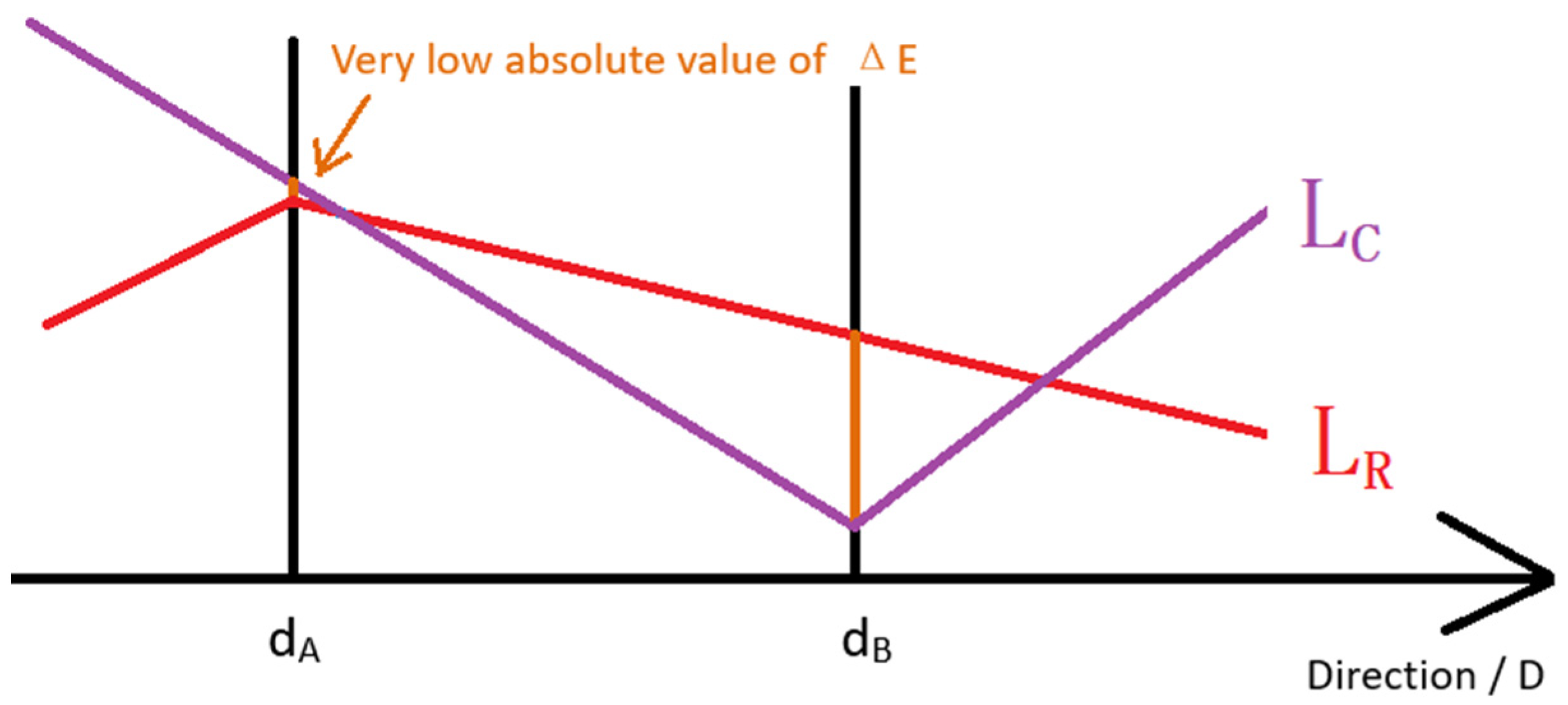

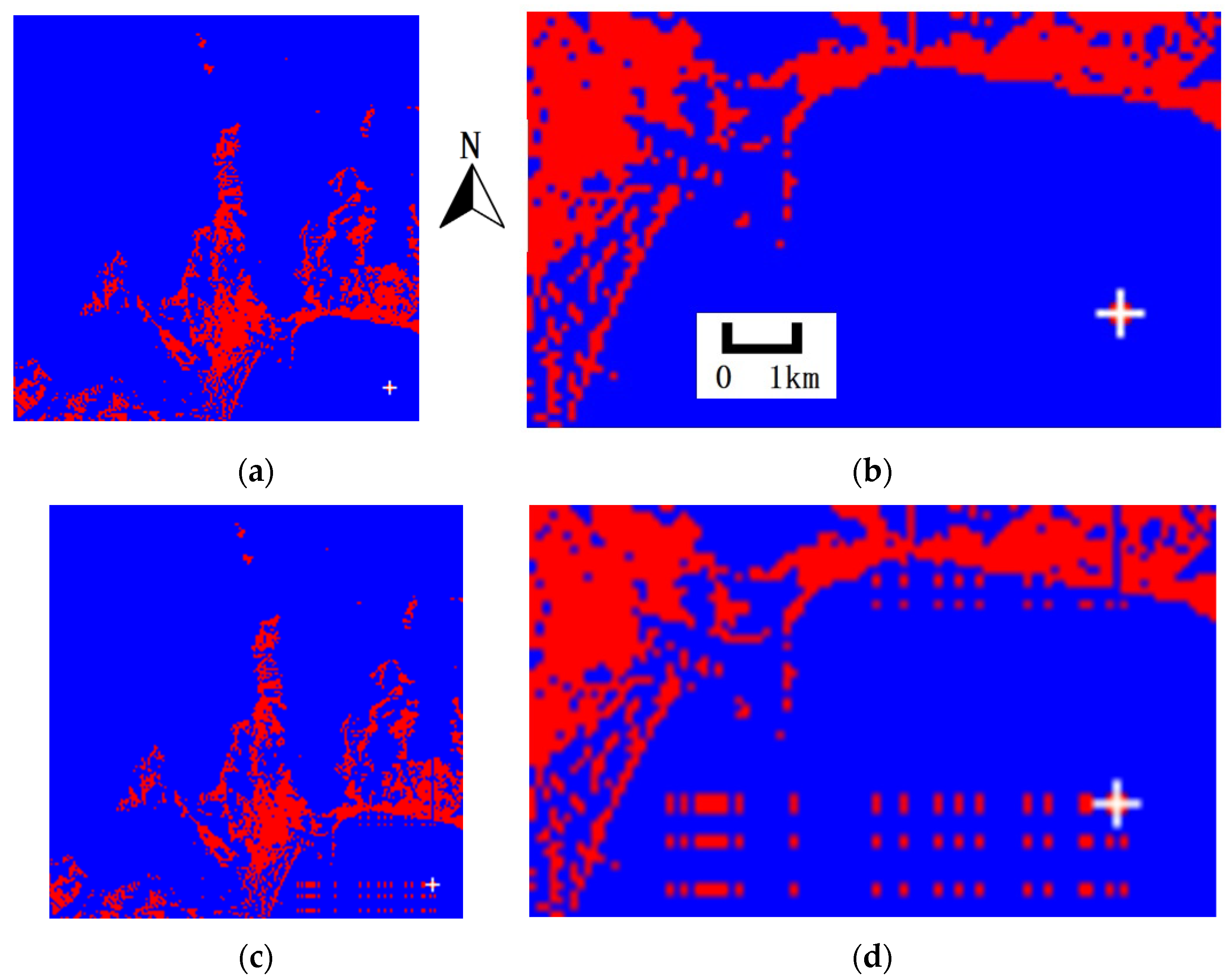
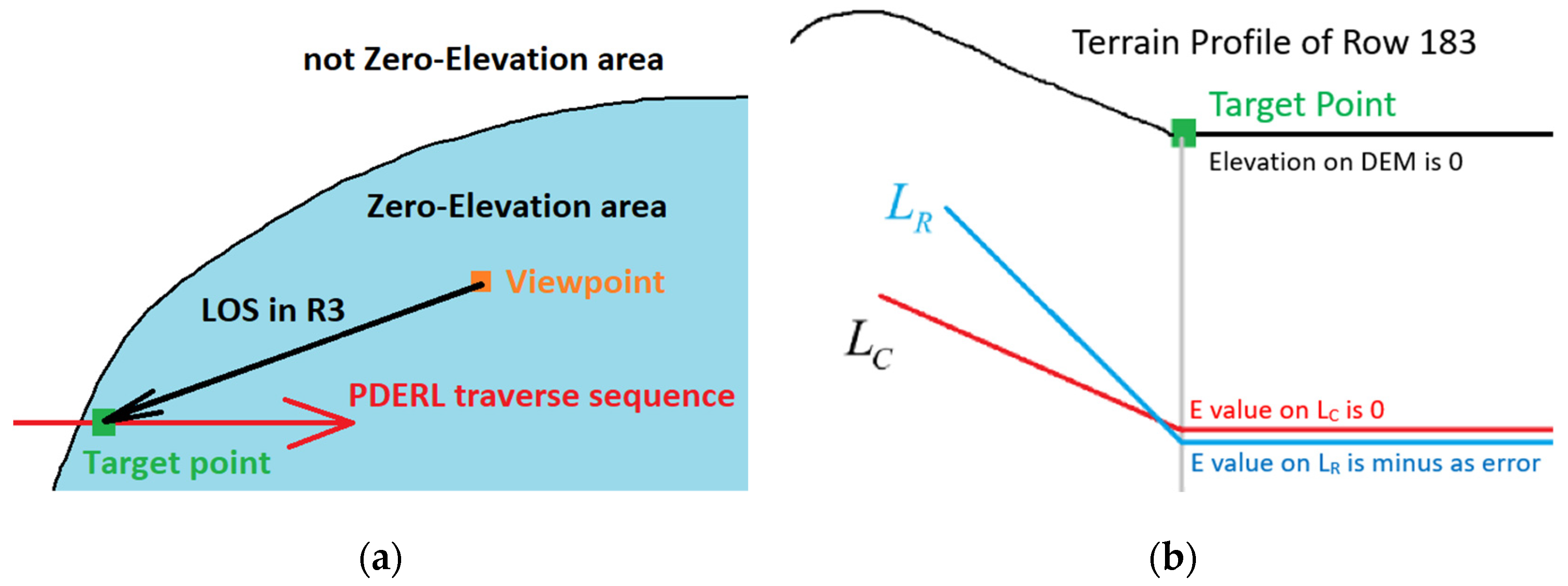
| Algorithms\DEMs | Mountains | Hills | Plains |
|---|---|---|---|
| PDERL (Original) | 42,545 (0.860%) | 108,061 (2.183%) | 115,522 (2.334%) |
| PDERL (Problem 1 solved) | 18,055 (0.365%) | 112,756 (2.278%) | 123,052 (2.486%) |
| HiPDERL | 73 (0.001%) | 429 (0.009%) | 313 (0.006%) |
| XDraw | 114,949 (2.323%) | 129,131 (2.609%) | 86,397 (1.746%) |
| HiXDraw | 110,491 (2.233%) | 102,810 (2.077%) | 42,725 (0.863%) |
| DEMs | Mountains | Hills | Plains |
|---|---|---|---|
| Total error number | 18,055 | 112,756 | 123,052 |
| Viewpoint number(Perfectly accurate) | 511 | 147 | 136 |
| Viewpoint number(Error rate below 0.1%) | 615 | 610 | 511 |
| Viewpoint number(Error rate 0.1%–0.5%) | 78 | 302 | 400 |
| Viewpoint number(Error rate 0.5%–1%) | 15 | 89 | 103 |
| Viewpoint number(Error rate above 1%) | 6 | 77 | 75 |
| DEMs | Mountains | Hills | Plains |
|---|---|---|---|
| Total error number | 110,491 | 102,810 | 42,725 |
| Viewpoint number(Perfectly accurate) | 4 | 25 | 84 |
| Viewpoint number(Error rate below 0.1%) | 401 | 482 | 910 |
| Viewpoint number(Error rate 0.1%–0.5%) | 706 | 626 | 291 |
| Viewpoint number(Error rate 0.5%–1%) | 93 | 98 | 22 |
| Viewpoint number(Error rate above 1%) | 21 | 19 | 2 |
| Algorithms\DEMs | Mountains | Hills | Plains |
|---|---|---|---|
| R3 | 126.028 | 92.207 | 62.311 |
| PDERL | 40.178 | 39.978 | 39.594 |
| HiPDERL | 45.710 | 45.197 | 44.725 |
| XDraw | 37.071 | 36.903 | 37.091 |
| HiXDraw | 45.275 | 44.292 | 44.108 |
Publisher’s Note: MDPI stays neutral with regard to jurisdictional claims in published maps and institutional affiliations. |
© 2022 by the authors. Licensee MDPI, Basel, Switzerland. This article is an open access article distributed under the terms and conditions of the Creative Commons Attribution (CC BY) license (https://creativecommons.org/licenses/by/4.0/).
Share and Cite
Cheng, H.; Dou, W. HiPDERL: An Improved Implementation of the PDERL Viewshed Algorithm and Accuracy Analysis. ISPRS Int. J. Geo-Inf. 2022, 11, 506. https://doi.org/10.3390/ijgi11100506
Cheng H, Dou W. HiPDERL: An Improved Implementation of the PDERL Viewshed Algorithm and Accuracy Analysis. ISPRS International Journal of Geo-Information. 2022; 11(10):506. https://doi.org/10.3390/ijgi11100506
Chicago/Turabian StyleCheng, Haozhe, and Wanfeng Dou. 2022. "HiPDERL: An Improved Implementation of the PDERL Viewshed Algorithm and Accuracy Analysis" ISPRS International Journal of Geo-Information 11, no. 10: 506. https://doi.org/10.3390/ijgi11100506
APA StyleCheng, H., & Dou, W. (2022). HiPDERL: An Improved Implementation of the PDERL Viewshed Algorithm and Accuracy Analysis. ISPRS International Journal of Geo-Information, 11(10), 506. https://doi.org/10.3390/ijgi11100506





